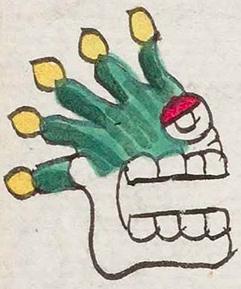Malinalco (Mdz35r)
This simplex glyph for the place name Malinalco features two-tone green grass (malinalli) with yellow tips, but here the grass appears as the hair of a skull in profile, facing toward the viewer's right. The skull is white, but its open, somewhat realistic eye is red and white, much like other eyes (and stars) in the Codex Mendoza. Its jaw is open. The skull does not figure in the place name in any phonetic way. And the locative suffix (-co) is not featured visually.
Stephanie Wood
This glyph harkens to the twelfth day of the twenty day signs of the tonalpohualli (calendar). Our online Nahuatl Dictionary cites the Historia Tolteca-Chichimeca for the crucial information that the word malinalli was part of a diphrasis, in nopalli, in malinalli, connected with bleeding and death. Another intriguing detail comes from Michel Graulich, who finds that the dried grass called malinalli, represented by a half skull with grass hair, is associated with "the moon, drunkenness, and the paranormal goddess Cihuacoatl Quilaztli, which is clearly an aspect of witchcraft." [See: Estudios de Cultural Náhuatl 22 (1992), p. 91.] Finally, Frances Karttunen reminds us that malina is the verb for "to twist something" (as in, to twist into cord), and malinalli is "that which is twisted." The other glyph for malinalli in the Codex Mendoza shows the grass as twisted (see below, right).
Stephanie Wood
malinalco, puo
Malinalco, pueblo (same name today, State of Mexico)
Stephanie Wood
c. 1541, but by 1553 at the latest
Stephanie Wood
The malinalli is at the top, so the reading starts there. The skull should be interpreted more than read, and it is merged with the skull.
wild grasses, twisted, skulls, nombres de lugares

malinal(li), grass, https://nahuatl.wired-humanities.org/content/malinalli
-co (locative suffix), at, https://nahuatl.wired-humanities.org/content/co
"...this place is named for the calendrical symbol rather than the grass itself." [Frances Karttunen, unpublished manuscript, used here with her permission.]
"On the Grass" (Berdan and Anawalt, vol. 1, p. 190)
Codex Mendoza, folio 35 recto, https://digital.bodleian.ox.ac.uk/objects/2fea788e-2aa2-4f08-b6d9-648c00..., image 80 of 188.
The Bodleian Libraries, University of Oxford, hold the original manuscript, the MS. Arch. Selden. A. 1. This image is published here under the UK Creative Commons, “Attribution-NonCommercial-ShareAlike 3.0 License” (CC-BY-NC-SA 3.0).





